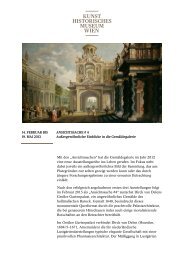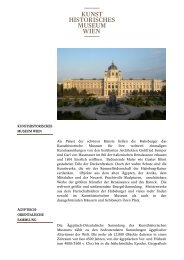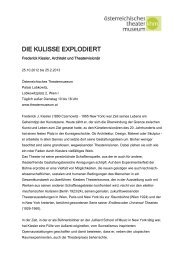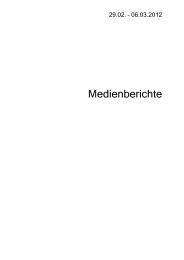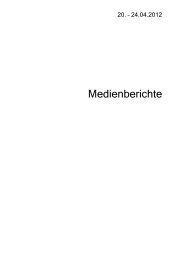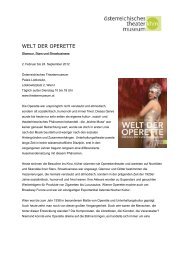KHM Jahresbericht 2012 - Presse - Kunsthistorisches Museum Wien
KHM Jahresbericht 2012 - Presse - Kunsthistorisches Museum Wien
KHM Jahresbericht 2012 - Presse - Kunsthistorisches Museum Wien
Sie wollen auch ein ePaper? Erhöhen Sie die Reichweite Ihrer Titel.
YUMPU macht aus Druck-PDFs automatisch weboptimierte ePaper, die Google liebt.
Preface<br />
Gustav Klimt was without a doubt the “man of the year” of <strong>2012</strong>. For his 150 th birthday,<br />
many Vienna museums organized exhibitions honouring this great artist of the<br />
Ringstrasse period. The <strong>Kunsthistorisches</strong> <strong>Museum</strong> and the Austrian Theatre <strong>Museum</strong><br />
each presented a special exhibit; as a particular attraction, we constructed a “Klimt<br />
Bridge” in the grand staircase of the <strong>Kunsthistorisches</strong> <strong>Museum</strong>, which was positively<br />
stormed by the public. For the first time since their creation, it was possible to view the<br />
spandrel paintings in the staircase produced by Gustav Klimt and his painters’ company<br />
at close proximity. Due to its enormous success, this bridge remained standing after the<br />
end of the Klimt show, until the beginning of 2013.<br />
this important object from the public, and have commissioned the architect Adolf<br />
Krischanitz to create a suitable presentation in the <strong>Museum</strong> of Ethnology. This impressive<br />
object can be seen again at Heldenplatz from mid-November <strong>2012</strong>, in a scholarly<br />
presentation accompanied by documentation.<br />
The Austrian Theatre <strong>Museum</strong> presented two highly successful exhibitions in <strong>2012</strong>: one<br />
on the phenomenon of operetta, in cooperation with the German Theatre <strong>Museum</strong> in<br />
Munich, and another on the architect and theatre visionary Frederick Kiesler, organized<br />
in collaboration with the Villa Stuck and with La Casa Encendida in Madrid.<br />
<strong>2012</strong> also saw a profusion of exhibition activities within the consortium of museums<br />
and abroad. The successful Winter Tales exhibit went to the Kunsthaus Zurich in<br />
February <strong>2012</strong>, and the Vienna Kunstkammer was presented through a representative<br />
selection of works in the Reiss-Engelhorn <strong>Museum</strong>s in Mannheim from late February<br />
<strong>2012</strong>. The two-month loan of the helmet and sword of the Albanian national hero<br />
Skanderbeg from the Collection of Arms and Armour to the National <strong>Museum</strong> in Tirana<br />
was of cultural and political significance. Minister Claudia Schmied and Vice-Chancellor<br />
Spindelegger conducted the opening of the exhibition at the end of November <strong>2012</strong>.<br />
In Ambras Castle, Kunstkammer objects from the Green Vault in Dresden were shown<br />
from July 13 th in a magnificent special exhibition.<br />
Early in <strong>2012</strong>, we started a very successful series of artists’ talks in the domed atrium<br />
of the <strong>Kunsthistorisches</strong> <strong>Museum</strong>, whose glittering launch featured the U.S. artist<br />
Jeff Koons. Talks with Martin Gayford, Nan Goldin, Ugo Rondinone, Kris Martin, Ed<br />
Ruscha, Lawrence Weiner and Bice Curiger followed. From April <strong>2012</strong>, the renovated<br />
Theseus temple in the Volksgarten was the site of a Contemporary Program, which has<br />
been extremely well received. By fall <strong>2012</strong>, 90,000 visitors had seen these exhibitions.<br />
In the Paintings Gallery, continued refurbishment took the form of rehanging of the<br />
galleries and reclothing their walls, together with improvements to the lighting and the<br />
labels. Director Sylvia Ferino also developed the new exhibition format Points of View<br />
in <strong>2012</strong>, which highlights one artwork from the collection four times per year. In the<br />
Collection of Arms and Armour, the Society of Friends of the Collection of Arms and<br />
Armour helped to finance the new presentation of an important group of objects<br />
related to the courtly hunt. A new society of friends was founded in Ambras Castle.<br />
In <strong>2012</strong>, the <strong>Kunsthistorisches</strong> <strong>Museum</strong> completed an important brand strategy and<br />
rebranding process, to be reflected in a new appearance of the three museums starting<br />
in 2013 and a new corporate design.<br />
In all, <strong>2012</strong> was a well-attended and economically successful year. We extend our thanks<br />
to all employees for their labours and great dedication during the reporting year. All<br />
those involved in the making of this <strong>2012</strong> Annual Report are likewise sincerely<br />
thanked.<br />
dr. Sabine Haag<br />
dr. Paul Frey<br />
director General<br />
CFO<br />
The structural renovation of the Kunstkammer was finished in mid-<strong>2012</strong>, and the reinstallation<br />
of the collection began in the fall. It was possible to remain completely within<br />
the planned budget. The date for the opening of the Kunstkammer was fixed for 28 February<br />
2013, through a so-called soft-opening already took place on 12.12.<strong>2012</strong>: under<br />
the motto “first room – first view”, the Berger Gallery was presented to the public,<br />
providing a first impression of the spectacular restoration of this collection.<br />
It should not go unmentioned that the <strong>Kunsthistorisches</strong> <strong>Museum</strong> has participated in<br />
the Google Art Project from <strong>2012</strong>, enabling a greatest possible number of people to<br />
share in the holdings of our museums.<br />
From 1 May <strong>2012</strong>, the <strong>Museum</strong> of Ethnology has Steven Engelsman as its new director,<br />
who will oversee the successful restarting of the museum and the complete reopening<br />
of this great collection by 2016. Since a loan of the ancient Mexican feather headdress<br />
(“Penacho”) to Mexico is not possible for reasons of preservation, as a multiyear<br />
Austrian-Mexican research project concluded, we wanted to no longer withhold<br />
10<br />
11





